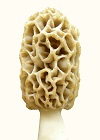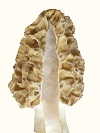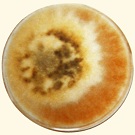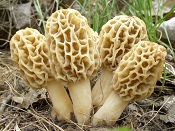 |
|
Research Photo Pages


|
A recent study (May 2011) of morel evolution claims the morel evolved 129 million years ago. The methodology was a mixture of biological opinion and phylogenetics. Phylogenetics is such a crude procedure that no two laboratories can get anything close to similar results. A small bit of DNA is looked at, and a few mutations are used to determine origins on the basis of a quack computer program. Morel scientists at the universities do not know that the morel recently evolved from a yeast, because they do not study physiology. Here are some reasons why the morel evolved from a single celled yeast between 80 and 20 thousand years ago: Morphology: The morel does not have a stable morphology. A growing procedure created by Ronald Ower results in large morels lacking ridges and having the appearance of balloons. Images of such balloon-like morels are shown in a magazine article (Vogel, S., 1988. Taming the Wild Morel. Discover, May, 1988, 9, 58-60.) Small morels did produce normal morphology, so small types were grown for some time, and then a deeper medium was used, which allowed larger morels to appear normal. An unstable morphology is not possible with other species. It is only the evolution from a single-celled organism lacking in multicellular morphology that allows an unstable morphology to exist. Otherwise, a stable morphology is passed on from all ancestors. Anomaly: The reversion anomaly is a result of recent evolution. Micro-morphology: The morel has no complexity at the microscopic level, while ancient fungi have complex micro-structures. The tissue of the morel uses rounded cells which look like potatoes, where square corners should exist. Without square corners on the cells, the tissue is extremely brittle and easily broken. The rounded corners on the cells shows that the morel has not had enough evolutionary time to create square cornered cells.
Ascospores: Ascopores are grossly inadequate for long term survival. Ascospores are embedded in tissue, and getting them out is so problematic that the morel cannot survive adverse conditions, and it dies out easily. Ascospores evolved in single-celled yeasts. They have no advantage with multicellular organisms. Physiology: Morel physiology includes residual autolysis and excretion of acid. All bacteria and yeasts break apart as they die off as a method of recycling nutrients, which is called autolysis. No higher organisms do this. Filamentous fungi need to survive for a long time under adverse conditions, which would not be possible with autolysis. The morel carries autolysis from its yeast ancestor, because it has not had time to evolve it away. Autolysis is detrimental to the morel; it has no advantages. It is simply a carry-over from the yeast ancestor. Dehydration: Morel mycelium will not tolerate exposure to the atmosphere. The morel is extremely restricted in its habitat due to an inability to tolerate dehydration. It must grow in wet sand or something similar. The most significant characteristic of filamentous fungi is their ability to tolerate exposure to the atmosphere. The morel could not acquire that characteristic, because such physiology is extremely demanding, and yeast gave it up due to their normal environment in liquids.
|
 The anomaly of the morel is a mixture of early evolution and later evolution. Such mixing is not possible with normal evolution, as the changes are very gradual. The morel created multicellular characteristics so fast and recent that the genetics can be scrambled under laboratory conditions.
The anomaly of the morel is a mixture of early evolution and later evolution. Such mixing is not possible with normal evolution, as the changes are very gradual. The morel created multicellular characteristics so fast and recent that the genetics can be scrambled under laboratory conditions.


